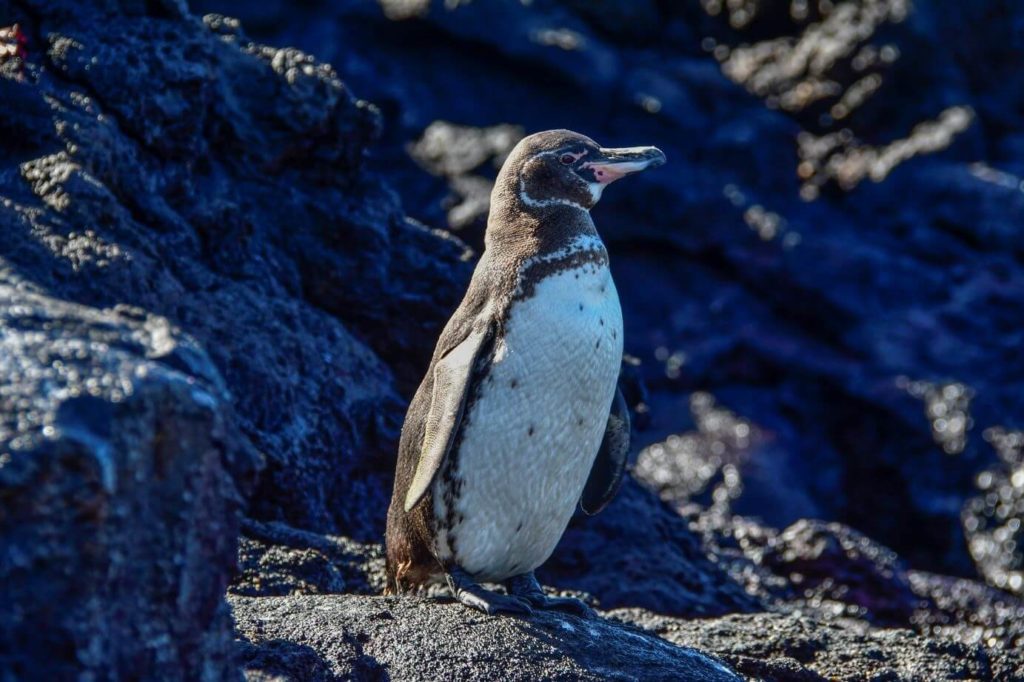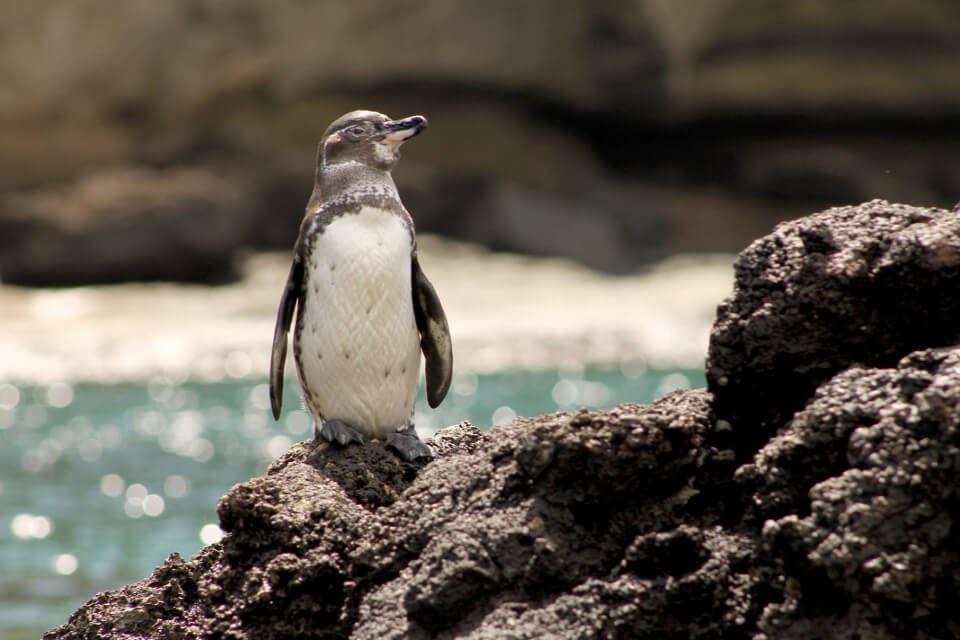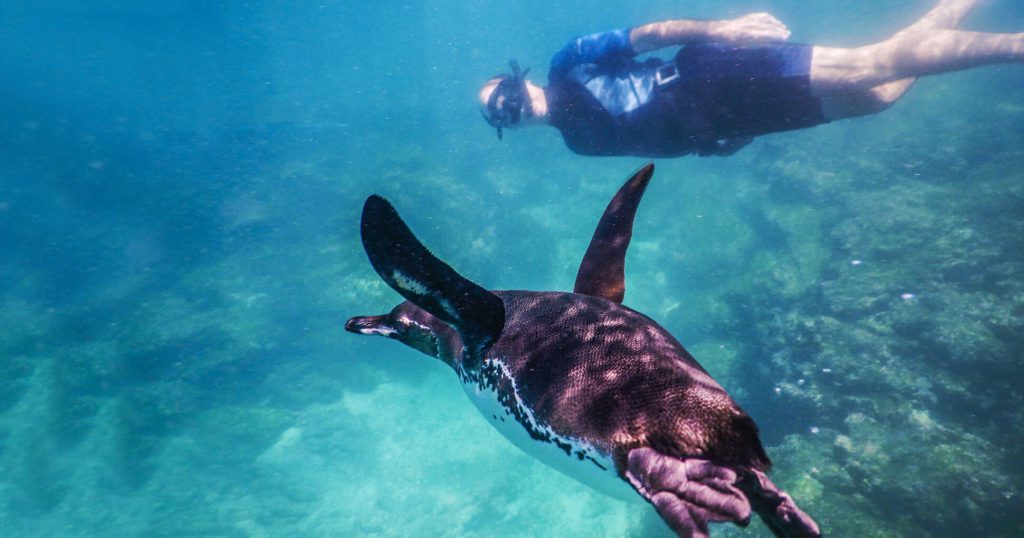The fact that an equatorial archipelago with tropical forests, arid deserts, and temperatures as high as 38°C (100°F) can support a species of Equatorial Tropical Penguin is one of the most extraordinary mysteries of the Galapagos Islands. Although there are other penguin species, only the Galapagos penguin is found this far north; even more astonishingly, it is situated directly on the equator. The narrative resembles a fairy tale about natural history.
TALK TO A DESTINATION EXPERT

Diego Zapata

Rosa Mena

Sandy Lara

Diego Zapata

Rosa Mena

Sandy Lara
Equatorial tropical penguins are adapted to harsh weather; as they move further south, their numbers and individual sizes increase. The mighty Emperor Penguin in Antarctica can withstand temperatures as low as -40°C (-40°F). Because of this, the Galapagos penguin has developed a variety of unique behavioral and physical adaptations that enable it to live in such warm climates.
HOWEVER, CAN IT LIVE HERE IN THE PACIFIC?
This penguin species can live here in equatorial latitudes thanks to several adaptations. The third-smallest penguin in the world, the Equatorial Tropical Penguin is an essential adaption for thriving in the warm temperature of the Galapagos Islands. It can fit into small caverns and crevices to hide from the intense sun because of its diminutive size—it is no taller than 20 inches. Not only that, but smaller populations don’t need as much area as larger ones, which is crucial in the Galapagos, where the Galapagos penguin has the shortest breeding range of any penguin species. Moreover, because they require less food due to their tiny size, penguins have a higher chance of surviving during times of scarcity.

Additionally, the penguins have a few strategies to shield themselves from the intense equatorial sun. Often, they are observed shading their sensitive feet with their flippers or keeping them away from their body to release heat through the exposed undersides of the flippers. The increased blood flow to these exposed places distributes heat even more. In addition, Galapagos penguins evaporate heat from their throats and airways by panting, just like dogs do. But swimming is the easiest way for them to stay calm. Like all penguins, they spend most of their time in the water, kept quiet by oceanic upwelling and the Humboldt Current.
THE HUMBOLDT CURRENT – THE COOL SIDE OF GALAPAGOS
Experts surmise that the Humboldt Current, which still plays a crucial role in the life of the penguins, is how the ancestor of the Equatorial Tropical Penguin got to the islands. The primary food source for Galapagos penguins is krill and small crustaceans; however, they also occasionally eat fish and squid. The Humboldt Current is a prerequisite for the food’s availability. Through the displacement of surface water and the upwelling of deep, nutrient-rich waters to the surface, the Humboldt Current transports frigid Antarctic water northward along South America’s western coast, forming one of the planet’s most productive marine ecosystems. The penguins depend on this current and the nutrients it provides to the islands to survive. The movement of the current is intimately correlated with their dispersion over the archipelago. The western islands of Fernandina and Isabela, which are heavily impacted by upwelling processes and the Humboldt Current, are home to more than 80% of the population of penguins. The remaining penguins reside on Bartolome, Santiago, Santa Cruz, and Floreana islands.

ONLY SOME THINGS ABOUT PENGUINS ARE PICTURE-PERFECT.
Climate change has had a severe negative impact on the penguin population in the Galapagos Islands in recent decades, as it has on many other species. The world’s rarest and most endangered penguin species, the Galapagos, has been finding it difficult to adjust to the more severe climate changes occurring in its natural habitat. Super El Niño events have increased in frequency during the past few decades, significantly impacting their food supply during those times. About 77% of the population perished during the El Niño that occurred in 1982–1983; 15 years later, the population fell by 66% more due to the El Niño that occurred in 1997–1998. However, the penguin’s ability to adjust to future changes is indirectly hampered by the population’s decreased genetic diversity, resulting from these notable population reductions. This has made the Galapagos penguin incredibly vulnerable, especially with its exceedingly limited breeding area. Many of the penguins’ 40-year-old nests had either been flooded, utilized by iguanas, or destroyed. To boost their population, conservation initiatives have been made, such as building artificial nests to improve the success of reproduction. Although the penguin population has grown gradually in recent years—there were only 1,000 in 2007—it is still highly vulnerable. All these natural causes may not always be as damaging as the effects of introduced species. Penguins can only find two ways to flee the volcanic coasts of the islands: either they head quickly into the ocean, which is something that chicks and juveniles will not be able to do at all, or they find small cracks in the rocks or empty lava tubes to hide.
TALK TO A DESTINATION EXPERT

Diego Zapata

Rosa Mena

Sandy Lara

Diego Zapata

Rosa Mena

Sandy Lara
EVERYTHING IS BETTER THAN SNORKELING WITH A TROPICAL ELEPHANT.
Spend a wonderful day snorkeling along with the iconic Galapagos penguin!
The most unusual experience for explorers is seeing penguins on land and in the water out of all the animals they encounter in the Galapagos. The explanation is straightforward: where else can you snorkel with a penguin in tropical latitudes? Looking at the underwater world of the Galapagos and seeing a parrotfish, a genuinely tropical fish species, and then a penguin swimming torpedo-like next to you, for example, seems rather strange. Observing a polar bear on a tropical beach is like this. A genuine “only here” wildlife encounter is snorkeling with penguins; fortunately, several expedition programs make this possible. Punta Vicente Roca, Bartolome, Chinese Hat, Floreana, and Punta Espinoza are among the well-known penguin tourist destinations.

Reviewed by: Francisco Dousdebés, Galápagos Expert, July 5th, 2016.
Photo Credits: Francisco Dousdebés


